Drawing from ephemeral experiences and shifting mythologies in contemporary society, Andreas Fischer creates thoughtfully precise, yet spontaneous, artworks that negotiate his place in the world. Recently, The COMP Magazine visited Fischer’s west Fulton street studio to discuss our common early experiences, his passion for cycling, his role as an educator, and the function of representation and touch in his paintings.
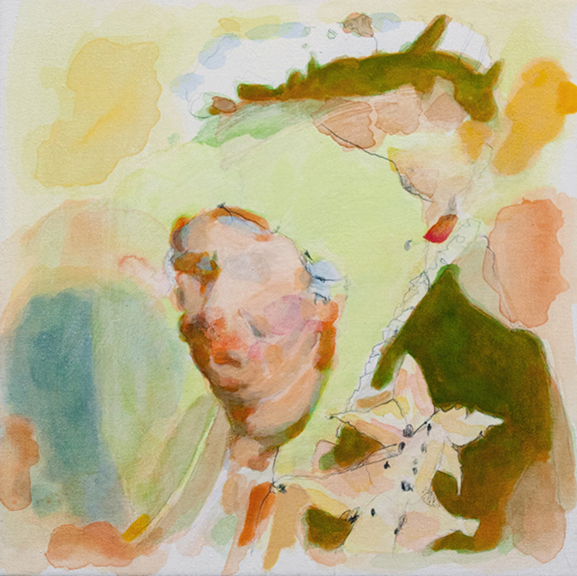
Andreas Fischer, Even the boldest might practice explosive syllables under her breath in order to reduce conventional binary oppositions, oil, acrylic, and pencil on canvas, 14″ x 14″, 2016
Can we start with a little background? You and I hold some common experiences. For instance, we both attended Southport High School in Indianapolis, Indiana. Are there any early life events or people that you see influencing your present trajectory as an artist?
I was excited to find out that we both went to the same high school and that we both ran cross country there. In retrospect I think I was totally lost during that time. I would say that most of the influences that I normally think about showed up for me starting in college, but in high school I think my major attempt to get though the world was through sports. I suppose that is kind of an obvious place to turn if you are midwestern kid. I tried lots of sports, but in high school I gravitated toward cross country, track, and road cycling – so maybe not the most usual ones. Cycling was the sport with which I got super obsessed. Unlike the conversation about battle simulation that gets put on sports like American football, bike racing lends itself more to conversations about social structure. Roland Barthes was a big cycling and his essay, “The Tour de France as Epic” is an interesting case of seeing the race as a kind of rolling literary metaphor that underscores this in mythological terms.
I think lots of sports work for this in some ways, but in cycling, especially in stage racing, you have races within races – riders competing for different jerseys, mountains, points, and the overall race or general classification; riders going for stage wins; and others who are there to do other kinds of jobs for their teams. These all take different kinds of riders. There is a bit of a hierarchy, but the different roles can all define different kinds of successful careers and there is a big range of ways to be a star on any given day. It is not just necessary to be an overall contender. Out of around two hundred riders in the Tour de France, for example, there are usually only around five or ten who are even at the race to try to compete for the general classification. There are typically several days in a stage races where other kinds of riders grab the headlines. Cycling is really like mixing different disciplines into one big world, sort of like if you put a whole track team on the track at once and started every race together, but it somehow works in a really interesting and expansive way if you can see all of the parts moving. All of this makes cycling very strategic and that invites people to think analytically about it.
In retrospect I think before it seemed like an option to be an artist, I put energy into thinking about cycling as a sort of reflecting device. Training, traveling, and racing was a world of its own that also seemed to model something about life in general. I think quite a bit of the way I think about work now somehow comes from thinking about cycling and sports in general as particular kinds of arenas with important implications about social structure.
I see painting and drawing activities as ways of carrying out material negotiations with representations. I like the idea that we construct ourselves and our worlds through the images around us and I think that images are contested territory. I think that we can manipulate the world by manipulating images. I am pretty sure that in high school I wanted to find a place in the world and have some ability to influence it through sports. These days I think that in some important ways art is just better suited to carrying out this kind of conversation, maybe because where sports has some very serious blind spots, art at least tries to value a wider range of orientations.
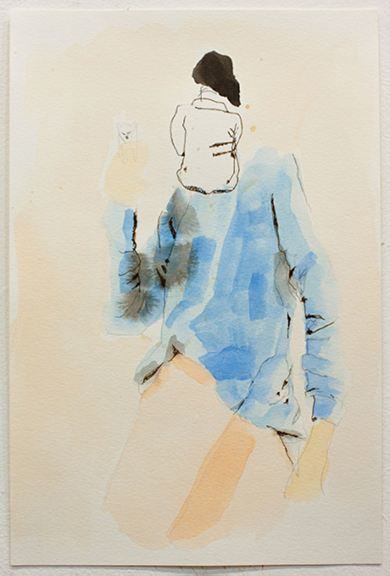
Andreas Fischer, What resourceful accordingly knowledgeable hands-on experience can accomplish in complex practice, pencil, watercolor, Sharpie, and Sumi ink on paper, 15″ x 10″, 2016
I’m fascinated with how you think about the various tenets of representation, the application of “touch” in painting and how you apply this inquiry into your painting process. Do you see any specific works you’ve produced that best illustrate these ideas?
Maybe paintings and drawings are something like a bunch of little voodoo dolls. If representations are ways of structuring the world then to make versions of them and then mess with them can be a way of effecting the world. This all happens for me through touch – action, speed (or lack thereof), the acts of constructing, taking apart and re-constructing a material version of an image. When the kind of painting I do works for me it is really a process of searching for and building a home in images and trying to make a place in the world by doing this. We get to choose our images, we get to own them in some ways, we get to alter and repurpose them, and try to get comfortable with them in our real lives. All the while, the social entities that are supplying these things to us are doing it with their own motives and manipulations. Touching, owning, re-working, and re-inventing the given world is how I think of what a certain kind of hand making is all about. Hand making is a strong political gesture for me, even if it is just doodling on a handout during a meeting. It is a way of indexing real human desires and movements often in response to something that tends to push the real human aside.
I have no idea how my work might function for others, but in my mind I am enacting these processes every time I work. I guess for me it is less relevant whether an individual piece does this well or is better than another because what is necessary in my mind is the process, the daily performance of this activity. It is how I live in and get through the world.
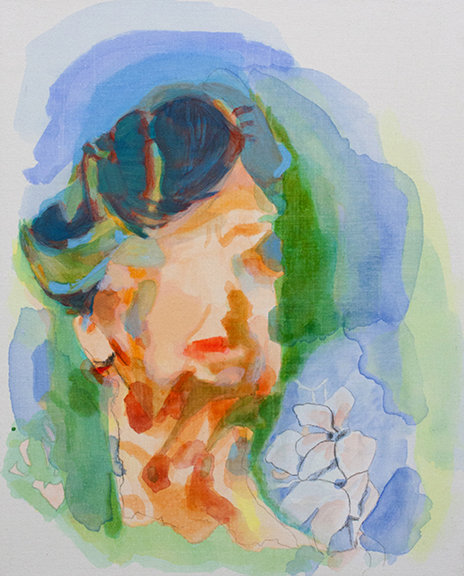
Andreas Fischer, The previous option belied the notion that interests actually matter in altering normative arguments, oil, acrylic, and pencil on canvas, 20″ x 16″, 2016
I am drawn to the artwork, Winter Promise (the significance of measures that could extend focus on incremental progress and increase chances of meaningful alteration), 2016. The formal and tactile elements contrasted with the foundation the title creates is puzzling (for me). Can you share with us a summary of your intent and process?
In my mind all of these parts that you mention are characteristics of the moving and changing relationships that, for me, painting and drawing are. I want this painting to operate as something that is happening, that is being figured out and that has not reached an arrival point. And I hope that this process of figuring out is a sort of triangulation between the image source material – what it means and how it points toward the social structure that generates it; the viewer; and the maker, who I always think of as the performer – each having an affective relationship to the others through the experience of the painting. I hope that this happens on an intuitive level so that no part is really able to tell the other parts what to do or think, but that there is simply an energy, an intent, or desire that each of the parts experientially offers the others.
The images that started this painting on its way are images that found me in the world – they were around me as I moved through the world at a certain time. I just reached out and tried to engage them by making them the ingredients of a painting. I think it started off as a way of asking them, “why do you keep showing up?” and “why do I keep thinking about you?” I think once they were in play it was just a case of trying to get them to work, which might have been a way to start to ask whether these questions offer anything significant. This took painting on the original canvas, cutting out shitty stuff that was just too annoying, working on other canvases and gluing that stuff on, drawing, whiting stuff out……and so on…….. I hope it feels like it could keep going because I could easily just put it on the wall and keep adjusting it. I could also, at any point, probably just give up and throw it in the trash. It simultaneously means everything and nothing to me, which is exciting and painful, but also keeps it about movement for me. I ‘d like the viewer to feel like wrestling with it as I very much like to do as a viewer with other paintings. I want to underscore and hopefully exaggerate basic functions of movement and mental participation that are probably in every painting if you look at certain things. I try to use touch and physicality (handmadeness) to index relationships to and in particular images. It is this action that is important to me, not what the images signify on an iconic level. We seem trained to stop at iconic reading when it comes to representation so it is sometimes difficult to expect to set up relationships of condition, desire, and action that extend beyond an iconic reading, but those are where I live.
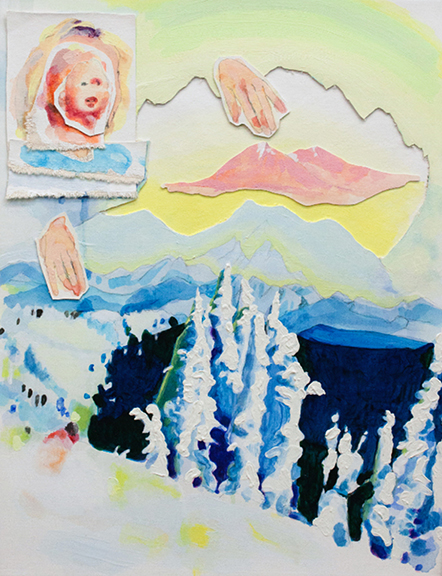
Andreas Fischer, Winter Promise (the significance of measures that could extend focus on incremental progress and increase chances of meaningful alteration), acrylic, pencil, and cut canvas on canvas, 22″ x 17″, 2016
The manner you assign titles to your work piques my interest. There is an obvious deliberateness in both the uncomplicated to lengthy designations. Is this process organic or do you have preconceived ideas for what you are attempting to convey?
I tried to set up the title to create a sort of action that echoes some of what I hope the painting might do. The title is long so it is a part of the experience that one can flow through. Even if one does not read the whole thing, I think just seeing and knowing its length indicates flow and movement – it is like a picture of a long trip. I hope the title gives a tone to the work in some obvious ways too, though – the relationship of the worlds “winter promise” and a snow scene, for example link to each other. In my mind the title never lands in a specific place. It is not a statement, but a little movement through some of the experiences that I think the images from which the painting began were manipulated or designed to create, except that I wanted to stretch the experiences out to just keep the whole thing in relational motion instead of what I think many images are designed to do, which is to come to a point, whether that is for commercial purposes or in order to enact other kinds of manipulations on us.
This came from the tendency to use images because of their relational functions as opposed to using images that sort of explain themselves through what they represent iconically. It can be confusing when a representational image gets taken apart and put back together to the extent that it may not stay recognizable. And it can be confusing if the iconic characteristics of an image do not explain its reason for being in the work, so I want to use text to try to set a tone for the kind of relational functions of the work. I want the titles to enact movement and process so they need to move and flow and keep going and not land in the place of statements, summaries, or directives. I am also fascinated with the tension between language and images so I want to play more and more with text and language next to image as part the range of characteristics of painting that are there to be exploited. I want it all to bounce round.
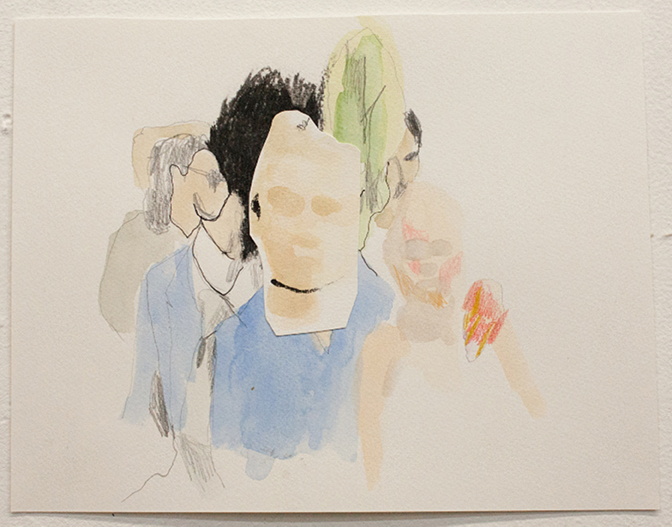
Andreas Fischer, The task of maintaining a widening sphere diminishes excessive pessimism, pencil, watercolor, colored pencil, Sharpie, charcoal, and cut paper on paper, 10″ x 13″, 2016
I sensed a level of calculation and organization similar to that seen in scientific experimentation in your studio approach. What do you value most in your aesthetic investigations?
I would say that it is more of a tension between a desire for certain kind of organization that I think in my case is ultimately compensatory and a total inability to really be organized and systematic. In terms of my working process everything is negotiation. That is both one of the fascinations for me and can also be overwhelming. I think because of the stress involved I have turned into a worker who is forever trying to come up with processes that I wish would sort of take me straight into the the kind of flow where a person can just get lost in the work for hours and days. Two things are true about this whole calculations and organizations thing so far though, I always fall for it and it never works. Not in a single work I have ever made have I been able to direct myself ahead of time successfully. It seems that there is discovery in making a plan and then watching it become totally beside the point, which is what I really value. There is something that happens for me when I finally just say “fuck it.” But in order to have that I can’t just start off giving up. I have to start off concerned about some things, fail, get upset, then stop caring. I have to have something to give up on and, I guess fortunately, I always start off thinking “this will finally be the time I can make a plan or system work” no matter how much of that kind of thinking has failed in the past. I think I wouldn’t know how to start if I didn’t have some something specific in mind.
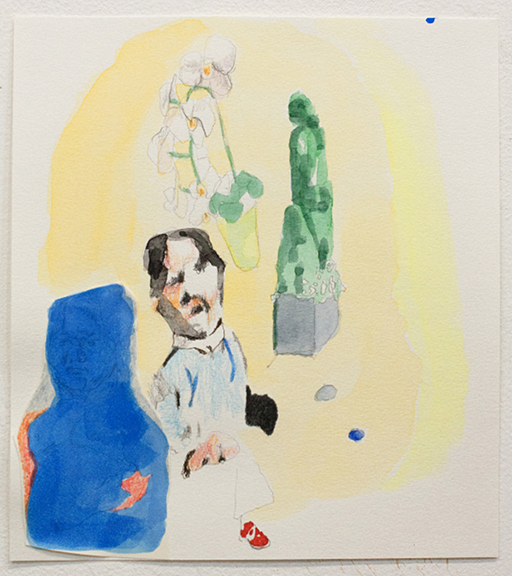
Andreas Fischer, It is worth mentioning that greatest achievements save rather than dispossess, pencil, watercolor, Sharpie, Sumi ink, and cut paper on paper, 11″ x 10″, 2015
In addition to working diligently upon your painting practice, you teach at Illinois Sate University in the College of Fine Arts? Are there any specific ideas or practices that you regularly attempt to share with your students?
I think art school is so much about language – about understanding in conscious language what art can be and how we can use it to have conversations with the world. This is maybe the biggest overall concern I try to enter into with students. I want to ask them what kind of conversation they need to have or want to have with their worlds, how they influence or intervene with their worlds and how to address this materially. For me this is project of being in art school.
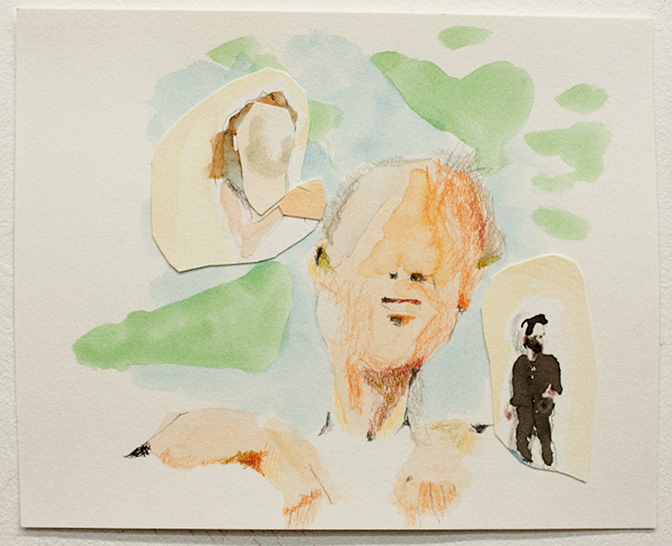
Andreas Fischer, Familiar organizing metaphors for structuring terms that remain most resolutely simplified and balanced, pencil watercolor, colored pencil, Sumi ink, and cut paper on paper, 10″ x 13″, 2016
So, what’s on the calendar for the remainder of 2016? Are there any specific exhibitions, projects or series of works that you are currently attempting to call closure to?
Right now I am getting ready for a summer show at Nathalie Karg Gallery in New York City that opens the first week of July. After that I will be working on a solo show for next year and I will have an essay, called “Post Critical Painting” in the anthology, Beyond Critique: Contemporary Art in Theory, Practice and Instruction forthcoming from Bloomsbury Press in the not too distant future.
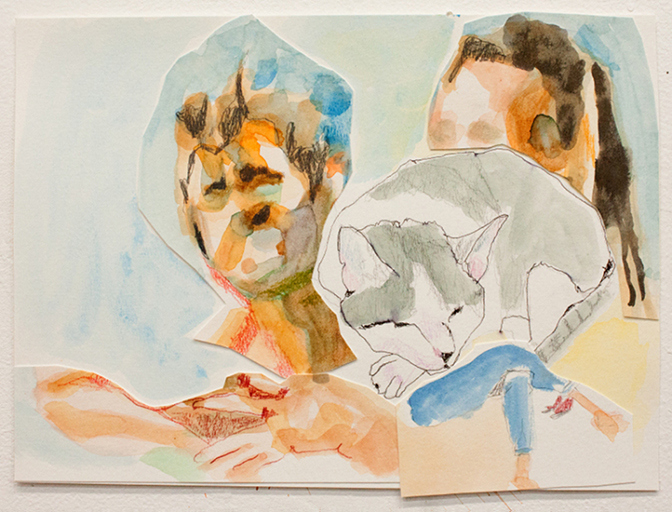
Andreas Fischer, You are somewhere spinning round the sun circling the moon traveling through time, pencil, watercolor, colored pencil, Sumi ink, Sharpie, and cut paper on paper, 10″ x 14″, 2016
For additional information on the artwork and practice of Andreas Fischer, please visit:
Andreas Fischer – http://andreasfischer.us/
Andrew Rafacz Gallery – http://www.andrewrafacz.com/artist.php?a_id=94
Bad At Sports – http://badatsports.com/2013/the-moving-surface-an-interview-with-andreas-fischer/
Chicago Magazine – http://www.chicagomag.com/Chicago-Magazine/March-2015/Go-See-Andreas-Fischers-New-Exhibit-at-Andrew-Rafacz-Gallery/
Artadia – http://artadia.org/artist/andreas-fischer/
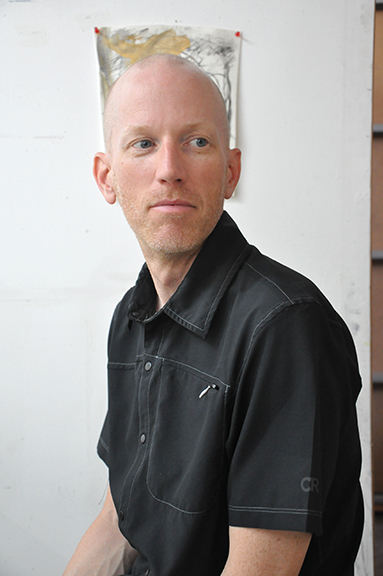
Andreas Fischer, painter, Chicago, IL, 2016
Artist interview and portrait by Chester Alamo-Costello


